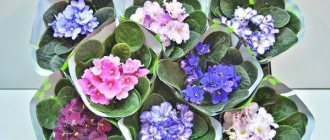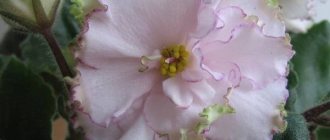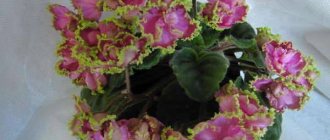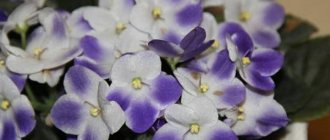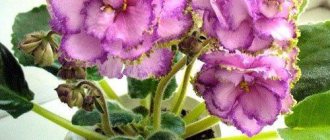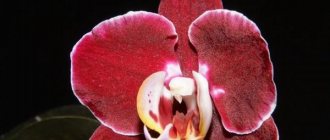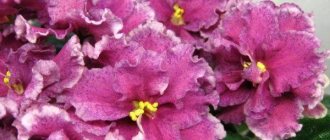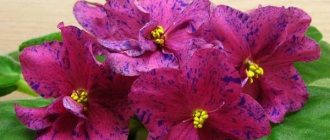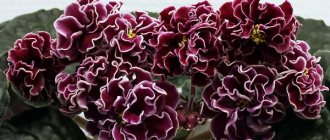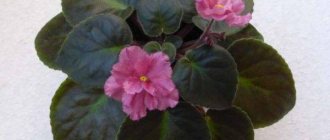Violet is one of the most common house plants. The diversity of their appearance and long flowering leaves no one indifferent.
There are more than 30 thousand registered varieties of violets alone , this indicates their popularity and ease of care.
The violet varieties PT-Yanina and PT-Dancing Geisha (T. Pugacheva) are no exception; they are unique and loved.
Violet PT-Ioannina
Evergreen herbaceous perennial, low growing.
Thanks to the painstaking work of T. Pugacheva, this gorgeous plant was obtained.
Genus, family
The violet variety PT-Yanina belongs to the Gesneriev family.
Genus: Saintpaulia violet. Indoor violet, the ancestors of which were grown in 1893.
The discoverer of violets was Baron Walter Saint-Paul, who served at that time (1892) as a military commandant in the Uzambara district. The first artificially grown plant was named after the Saint-Paul genus (Saintpaulia).
Origin story
The creator of the Yanina variety is breeder Tatyana Pugacheva from Kursk , Russia. The variety was released in 2014.
Attention! The initial letters before the name of the variety usually indicate the initials of the author of the variety. In this case – PT.
Photo and description
Features of violet PT-Ioannina:
- the socket is smooth, neat, exhibition;
- leaves are simple, dark green;
- the outer petals of the flower are greenish, and they remain that way until the end of flowering;
- Ioannina violet flower is pale pink, large (5 - 7.5 cm), semi-double;
- A lilac-pink border adorns the edges of the delicate petals. Usually the border appears only during the second flowering;
- during the entire flowering period, the flowers do not fade or even turn pale;
- Flowering is bouquet and long.
Blooms elegantly. Look at this photo of the PT-Ioannina violet, the border on the petals is clearly visible here. No two colors are the same.
Variegation, imprints
The PT-Ioannina variety is not a variegated variety. The leaf plates in the rosette have a uniform color.
Sports
Flower growers use the word “sport” to refer to the children of the Uzambara violet that have not inherited the genes of the mother plant. This happens, but the phenomenon does not mean that a new variety has been obtained; this phenomenon is considered a defect . Even if the resulting plant is many times more beautiful than its parent.
Features of flowering, growth and reproduction
Much in the behavior of violets is determined by the nuances of care. Some petals darken very early, while others do not have a border at the tips.
It is necessary to realize that the environment has a significant influence on varietal characteristics.
The growth and reproduction of this variety is no different from most varieties.
When rooting stepsons, you need to remember that the plant needs a special microclimate , so to create it you should put a thin plastic bag on the pot.
Development at home
The plant will respond well to good care. You can safely hope for a positive review from this variety, observing the following conditions:
- temperature range within 18 – 23°C;
- the duration of daylight is at least 12 hours a day;
- correct and timely watering and replanting.
How long does it take to grow an adult plant?
It is possible to obtain an adult plant of the PT-Yanina variety only vegetatively.
The fastest way is to root the stepson (if any) in sphagnum.
Moss retains moisture well and has strong antibacterial properties.
Sold in flower shops.
How are varietal characteristics transmitted?
The Ioannina variety is propagated by leaves, but it is recommended to cut the cutting shorter , or even leave only the leaf blade.
Violet children generally retain the varietal characteristics of the parent . To find out if this is true, you need to wait for flowering.
Flowering in hot and cool conditions
Like all Saintpaulias, Ioannina does not like direct sunlight . They discolor flower petals.
Heat greatly affects the duration and quality of flowering, and not for the better. Lowering the temperature will help correct the situation.
What do flower stalks look like?
Ioannina’s flower stalks cannot be called too short. Medium length, strong and erect. They present pink flowers as a jewel and it looks very advantageous.
PT-Ioannina has quite long flower stalks.
Is it possible to achieve cap flowering?
Very patient people can try. For several months after transplanting into an adult pot, it is necessary to pinch off all emerging buds . All! Angry Janina will react with a bouquet of flowers.
Reviews
Mayorova Irina. Kyiv. “In the first flowering there were very few flowers, or rather there was only one. But what a one! I'm looking forward to the next bloom."
Antonina Sivokon. Mogilev. “I fell in love with the variety at first sight and, I must say, mutually. The variety is flexible, blooms beautifully and for a long time. No complaints yet.”
Violet Jolly Redneck – variety description
Mysterious Saintpaulia Jolly Redneck.
Very compact variety. Miniature.
The rosette is compact (no more than 11 cm in diameter) and grows leaves quickly .
The leaf blades are dark green, red on the back.
The flowers are small, no more than 2 cm, but against the background of a small rosette they seem larger than they really are.
The bush looks like a boutonniere.
The color of densely double flowers is not uniform, from dark pink, coral, to reddish. It’s difficult to describe this color ; everyone sees it a little differently.
Peduncles are strong and not long. Flowering is long .
Flowering is quite long. However, over time the flowers fade slightly.
Sports Jolly Redneck
The color of the variety and the shape of the flower are very interesting . To many it resembles peonies.
The variety is not prone to sports.
Features of keeping and caring for Jolly Rednek
An elegant and festive variety. Not capricious , easy to care for.
Easy to propagate. It grows on the wick without any complaints . The leaves are growing at a rapid pace. When replanting, it is necessary to remove a number of lower leaves. The cuttings take root well and grow babies without delay.
This violet is very easy to care for.
Attention ! There is a possibility that when transplanted into a larger pot, it will lose its miniature size and become standard in size .
The first flowering is not always successful ; there is no need to rush to conclusions in this situation. In good light, flowering is frequent and long-lasting. The distance to the light source should not be more than 25 cm.
Does not love:
- Drafts;
- Direct sunlight;
- And also dark and cold window sills.
The duration of daylight is at least 10 - 12 hours .
Replanting is required twice a year.
Reviews of Jolly Redneck
Marina V. Volgograd. “The variety is unpretentious and there were no problems with cultivation. My Redneck is already blooming, but I took it with a leaf. I really liked the variety. I recommend".
Svetlana Kolesnikova, Rossosh. “I’ve been growing this variety for quite a long time, I want to say that the variety is average both in terms of growth rate and difficulty of cultivation. Doesn’t indulge in frequent flowering.”
Violet PT-Dancing Geisha
An unusually beautiful variety.
Large, with elaborate frills, bewitchingly beautiful flowers.
Genus, family
PT-Dancing Geisha belongs to the Saintpaulia genus, Gesneriaceae family.
Origin story
The famous Kursk violet breeder Tatyana Pugacheva created her next masterpiece in 2018 . The variety quickly gained popularity.
Features of the variety
Below you will find a photo and description of the violet PT-Dancing Geisha:
- the flowers are very large . The white wavy-corrugated border goes well with the main light crimson color of the flowers. The petals are very showy, the center is white. The flounces look stunning!
- the rosette is medium in height, medium-sized, leaf color is green with an olive tint;
- flowering is lush, abundant, long lasting.
Variegation, imprints
These qualities are varietal characteristics. Variety PT-Dancing Geisha, non-variegated.
Sports
Sport is a violet that blooms out of sorts. During the process of mutation, the offspring of a given variety may have a different color or have leaves of a different shape. An adult plant cannot be propagated. And it is impossible to derive a variety from it.
To protect yourself from the appearance of sports, you need to root the leaf without a cutting, from the leaf plate.
Features of flowering, growth and reproduction
If you follow all the rules for caring for this variety, the flowering is long and bright.
The intensity of flowering depends on the temperature in the room where the plant is located.
Development at home
PT-Dancing Geisha is a non-capricious variety and does not require special care.
However, you should follow some simple rules:
- water into the edge of the pot or through a tray;
- they do not like bright direct sun;
- in the shade the leaves may lighten and the petioles will stretch out.
How long does it take to grow an adult plant?
The fastest way to get an adult plant is only from the stepsons on the mother bush. They are cut off and rooted.
Propagation by cuttings takes longer.
How are varietal characteristics transmitted?
In vegetative propagation, a daughter organism is obtained from the parent material. The rudiments of a new plant are formed at the site of the cut, and this is how the regeneration process begins.
Flowering in hot and cool conditions
In the hot summer, the color of the flowers may fade. With the onset of cooler temperatures, the color is restored.
What do flower stalks look like?
The PT-Dancing Geisha variety has short peduncles. Heavy large flowers lie beautifully on a green rosette.
The peduncles of PT-Dancing Geisha are short and strong.
Is it possible to achieve cap flowering?
Violets will reward you with cap blooms if:
- The transplant was made on time. It is better to carry it out with complete rejuvenation;
- after transplantation, you cannot fertilize (the soil is fresh);
- length of daylight hours 12-13 hours;
- temperature within 20-23° C;
- The buds are removed for at least 3 months.
It's not difficult, but it's worth a try!
Flowering duration
Typically flowering lasts from 6 to 10 months a year. After this comes a rest period, which averages two months.
The break occurs during the hottest summer time. But this can be corrected by creating an appropriate microclimate.
Some gardeners claim that with ideal care, flowering can continue all year round. However, such continuous flowering greatly exhausts the plant.
Reviews
Marina Antokhina. Moscow region. “The flowers are very beautiful, but I had to form the rosette myself.”
Yulia Morozova. Crimea. “The dancing geisha is truly, as described, excellent! I recommend to everyone. I’ll especially note the color of the petals, awesome!”
Violet RM-New Year's Tale (N. Skornyakova)
Beautiful violet New Year's Tale.
Creator of the variety
A magical variety with fluffy outlines and fantasy shades of pink and lilac flowers appeared in the process of painstaking scientific experiments with Uzambara violets by Natalia Skornyakova, who is rightfully considered a representative of the new wave of the domestic breeding school.
The Kursk master has been demonstrating his own varieties of tropical beauties to violet growers for about twenty years - since the beginning of the new century. Its varieties differ:
- The originality of the decorative contour;
- And the stability of varietal characteristics.
Copies of N. Skornyakova’s varietal line are characterized by the presence of the branded abbreviation “RM” , as they are dedicated to the master’s mother, Raisa Mikhailovna.
This variety was developed by Natalya Skornyakova.
ATTENTION! The violet variety, which appeared at exhibitions in 2015, constantly receives favorable reviews from specialists and flower growers.
Taxonomy
When taxonomically systematizing botanical objects according to official hierarchical principles, flower growers attribute varietal violet to the genus Saintpaulia (from the Gesnerieceae family), inexhaustible in the breadth of subspecies representation covered and unimaginably beautiful in the artistic decoration of silhouettes and images.
Violet specimens :
- According to the average cluster size coefficients, they are included in the standard section group;
- And according to the degree of flower filling, it is in the double subspecies.
Violet belongs to the terry subspecies.
Photo and description of the variety
Varietal violet can be described as an absolutely picky plant . When she appears in a room collection, she independently begins to unfurl a leaf rosette, trying to withstand:
- Varietal conditions;
- And harmonious outlines.
In the case of this variety, the help of a grower is not required during the plant growth process .
IMPORTANT! Collectors value such violet “independence” quite highly and choose varieties that can save them energy and time at the time of their initial development.
Under ideal indoor microclimate conditions, the growth of the specimen begins thanks to the careful and purposeful placement of newly emerging leaf blades by the developing violet across several tiers of the rosette in an order that in general resembles the architectural technique of mosaic alternation of leaves relative to each other.
Subsequently, an adult violet gradually acquires a symmetrical silhouette with :
- Smooth contours;
- And the spatial volume of the average degree of filling of the bush.
Moreover, each violet leaf can have a sufficient amount of solar energy required for life.
In terms of its overall volume and spatial size, the varietal violet is a representative of the section of the standard subspecies - its bushes with age do not exceed the average numerical indicators of the type. The obligatory compactness and aligned outlines of the rosette provide the classic texture of the violet variety.
Medium-sized leaves to characterize the size of the violet have:
- Quite ideal - rounded shapes with a slight smooth taper at the end;
- Smooth, glossy surface;
- And a weakly expressed venation pattern, more noticeable on the back side of the plate.
The leaves have a tone of bright summer green . The contours of the leaf plates have a wavy texture, which gives the bush extra volume in the growth plane. Along the edge of the leaves there is a small pattern of finely rounded teeth.
The leaves of Saintpaulia have the color of summer green.
NOTABLE! The flowering of varietal violets is accompanied by the appearance of lush caps with age, which are almost always in a state of budding.
To preserve the splendor of the decorative silhouette and maintain the health of the plant at a sufficiently high level, experienced specialists advise novice flower growers to give their pets a forced rest - just from time to time, carefully remove some of the formed flower stalks.
Violet flowers belonging to the “star” type are distinguished by:
- Significant volume;
- Large in size;
- And terry formatting according to the density of filling the corollas with petals.
An even greater increase in the spatial splendor of the flower occurs due to the wavy configuration and the strong degree of frilling of its edges.
Another obvious feature of the author’s description of the violet is the type of coloring of its flowers : the color scheme of the corollas contains an active mixture of pastel shades:
- White;
- Pink;
- And lilac colors of varying degrees of manifestation of their intensity.
The variety in question has an unusual color.
On top of this marvelous main background, quite bright colors appear :
- Fantasy stripes;
- And touches of bluish-lilac tonality.
In some specimens, along the edge of the frilly petals there may be a thin edging of soft green color . The center of the corolla is certainly distinguished by the presence of a white star.
Sports
Violet is distinguished by the intense repetition of varietal traits of flowers , confirmed by the author's description of the variety.
Pink sport is found in Saintpaulia.
But in some cases, rare formation of sports varieties that differ from the main variety is possible:
- The presence of an even color scheme of pinkish shades;
- And a complete absence of fantasy patterns.
Sometimes there is also a White-blue sport in this violet.
ATTENTION! Based on the pinkish sport variety of violet, the delicate sport RM-Gzhel was obtained and officially registered with registration: the range of its flowers consists of white and lilac-violet shades without fantasy.
Sometimes there are subtle shades of sports.
In this sport of violets, variations in color intensity are possible.
Rules for caring for Saintpaulias at home
If care were difficult, violets would not be so popular. Like all indoor plants, violets have their own care rules.
Conditions of detention
Violets really don't like large pots . A pot whose diameter is 3 times smaller than the diameter of the rosette is considered ideal.
A guide to determining the optimal pot size.
Attention! The transplanted violet will not bloom until the entire earthen ball is entwined with roots.
Proper watering and fertilizing
When choosing an irrigation mode, the orientation is to the top layer of soil:
- dry - water;
- wet - do not water.
Stagnation of moisture in a pot with a plant leads to the appearance of various kinds of insects in it. As a result of their vital activity, the substrate becomes unusable, which negatively affects the root system and the plant.
Fertilizing is carried out only as needed, this happens during the period of intensive growth of leaves. Fertilizer is applied along with watering.
Lighting and temperature
The violet needs light, but not bright and direct, but diffused.
All windows are suitable
The duration of daylight hours ranges from 12 to 14 hours a day.
Air humidity
Dry air affects flowering. It would be more correct to say that at low humidity the violet will not bloom.
What kind of soil does he prefer?
Experienced collectors and flower growers claim that there is no specific and especially ideal verified recipe for making a soil mixture for violets. In each region, the components sold are quite different, and the composition of the soil always depends on the size of the collection and even on the financial situation.
Another thing is that the basic principles of compiling soil mixtures for violets are always the same. The soil mixture should be:
- breathable;
- moisture-absorbing;
- low-fat;
- loose;
- easy.
There are many recipes for preparing soil mixtures. By exchanging one component for another, the most suitable composition is selected. Many people successfully use store-bought ready-made substrates.
In stores you can find various ready-made soils for violets.
Attention! The soil mixture for violets is not reused!
Pruning and hygiene
Adult violets need timely pruning of old leaves.
to remove faded flowers and peduncles as they appear . After all, they are no longer aesthetically pleasing; a new wave of flowering is being stimulated.
Washing dusty leaves is necessary. After the procedure, you need to let the flower dry in the shade.
Reproduction methods
Three possible methods of reproduction:
- leaf;
- baby;
- seeds.
Violets are mainly propagated vegetatively . Growing plants from stepsons is the fastest way.
Stepsons.
If the violet has released a miniature plant from the leaf axil, it is grown, cut off and rooted. It is most convenient to do this in small plastic containers using sphagnum moss.
Thus, in a fairly short period, an adult plant is obtained that has retained all its maternal forms. The whole process takes 3-4 weeks.
There is another way to obtain a new plant - from a leaf cut from the mother specimen and planted in a glass.
For propagation, take any leaf from the rosette in the top or middle row . The cut is made oblique and dried or sprinkled with crushed activated carbon. The resulting cutting is placed in water for rooting.
The water is changed once every 7 days. Roots appear within a month. Next, we plant it in the soil mixture and wrap it in a plastic bag.
The result of the work is a plant grown independently. This method is longer and will take 2-3 months.
Transplant rules, rejuvenation
It is recommended to replant violets as they grow. Adult plants - every six months. Children are transferred more often, after 2 or 3 months.
The best time is autumn or spring.
Attention! Transplantation during budding or flowering can be carried out only if absolutely necessary.
Care techniques in indoor culture
Violet responds well to simple but most necessary agrotechnical measures, provided they are carefully carried out with mandatory regularity :
- The plant should be placed on a window facing west or east; specimens from windows to the north should be provided with additional rays with a diffuse spectrum; to the south, unobtrusive artificial protection is required. When young, the variety prefers placement on shelves;
- Watering is shown in small doses from the moment when slight drying of the upper volume of the substrate is visually clearly visible;
Saintpaulia requires proper care. - It is best to apply additional fertilizing with mineral fertilizers
- Provide light primarily during the day, long-lasting, with a spectrum of scattered rays;
- Control a constant heat level within +20 + 24°C ; eliminate sudden fluctuations in the temperature gradient;
- Plant the rosette in nutritious, permeable soil with good aeration; ensure the creation of a volumetric drainage layer;
- When transplanting , use transshipment more often if there are no special indications.
